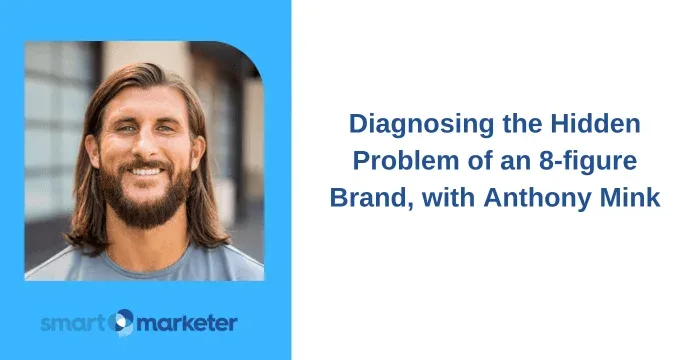If you’re a marketer or entrepreneur, obstacles aren’t new to you: we’ve all dealt with inconsistent growth, competition out the wazoo, and CPAs shooting through the roof.
But what happens when you encounter a problem, and you can’t seem to find a solution?
That’s what happened to Anthony Mink, CEO of 8-figure ecommerce brand Live Bearded.
So I asked Anthony to jump on the blog to share the story of his entrepreneurial setbacks, and how he diagnosed the problem that led his company to the right answers.
In this post, you’ll learn:
- What Anthony discovered after a $100,000 loss
- The hidden issue he found in his marketing & front-end offer
- Why you should focus on your customers’ problems (not your company’s)
The Ecommerce Explosion
During Covid, most brick-and-mortar stores suffered while ecommerce businesses lassoed the moon. When going to the store became impossible, ecom became vital in meeting customer demand safely and simply.
So it’s no surprise that Anthony’s company, Live Bearded, saw a drastic change in their numbers (a change you may have experienced yourself).
In 2020-2021, Anthony experienced high growth rates of 40-50% quarter after quarter. It was amazing!
But when bans and lockdowns began to lift, average growth rates plummeted to 7% quarterly – the lowest rates most had seen in over 12 years.
What was causing this? What was the problem?
Anthony crunched some numbers and found that the global growth of the number of ecommerce companies skyrocketed from 9.7 million in 2020 to 26.5 million in 2023.
And in 2021, the year-over-year growth rate averaged at 204% while it was just 1.1% in 2023.
The State of Ecommerce in This Economy
Everyone saw the rocketship during Covid and wanted it to take them to the moon. But instead, it left us with:
- Slow growth rates
- Heightened competition (half residing in the United States)
- And advertising costs at all-time highs
We know that inflation rates have soared and for the first time in history, outstanding credit card debt has peaked at over a trillion dollars.
In Anthony’s words, “If I wanted to sell you something, I’d tell you that our year-over-year growth rate was up 25% and stop there, but that’s not the full story.”
The full story was that:
- Their CPA was up 100%
- Acquisition was down 50%
- And they lost $108k in June/July
Ouch!
Live Bearded made 25% more revenue, but they made 10% less profit.
Any time that happens, as entrepreneurs we have to step back and ask, “What the hell happened?”
Anthony knew that the best thing to do was to take a hard look at the state of his business, and where most people reactively search for surface-level problems, he dove DEEPER.
He knew he hired amazing creatives with phenomenal ideas, but their ideas weren’t solving their acquisition problem. In Anthony’s words, “Sometimes you’re just doing too much shit!”
Ideas are great, but they have to solve the problem.
Cut the Crap. Diagnose the Problem.
A quote that Anthony says repeatedly is:
“Few things are as stupid as running in the wrong direction enthusiastically.” –Keith Cunningham
This seems obvious, but sometimes the hardest step is admitting that you turned the wrong way on a one-way street. (For Anthony, that admission came from a $100,000 wake-up call.)
But how did Live Bearded diagnose the problem?
They performed a full-funnel analysis by laying out the current buyer journey from ad click to conversion. They had to know what worked and what didn’t.
First, Anthony checked his sales funnel. He optimized his Sample Pack page where customers tried 24 different products for only $10. He found that 35% would come back and reorder, and they’d break even at 45 days.
THIS was not their problem; the numbers were solid and doing well.
So, he moved along.
Analyzing Acquisition Costs
Then he looked at their cost per acquisition (CPA).
In January, CPA was $15 and by June it had increased to $33. So they took a closer look at their ads to see what was working and what wasn’t.
At that point, Live Bearded’s most successful campaign was a “Try to Buy” ad that offered their sample pack of 24 products for just $10, plus a free gift.
This incentivized customers to buy straight away, find a product they liked, and boomerang back.
They kept launching new campaigns that repackaged this message to see if they could compete with the original ad. The problem was…
Every. Attempt. Failed.
Plus, they had thrown money into a feedback loop without trying to understand the formula of its initial success.
Ultimately, their ads were gambling.
And you’ll never win a hand if you’re playing a game you don’t understand.
Positioning and Testing Ads
Eventually, Anthony decided that in positions like this, questions are the best answer.
Questions like:
- How are we positioning our product?
- What problem are we solving?
- What problem should we solve?
- What does our audience really want?
Anthony’s first diagnosing question was: “How are we positioning our product?”
They positioned it as a “try before you buy” offer, but they weren’t solving any beard-related issues. If anything, they were solving the shopping experience.
They also looked at how they were framing themselves. The framework followed a Benefit/Desire model rather than a Problem/Solution model.
Here comes the lightbulb — the AHA! moment…
They had to go back to speaking to the experience of having a beard. They weren’t speaking to the problems their customers were facing, and this created problems for sales, CPA spend, and their overall success.
Anthony realized that all their problems boiled down to the fact that they weren’t SPEAKING to their customers the right way.
Speak to the Experience of Your Customer
So Anthony decided to start focusing on his customers’ problems instead of his company’s problems (which helped solve both).
As Anthony explained, we buy external solutions for internal problems: we buy stories, emotional states, and identities that signify who we are.
If you’re not paying attention to all of these in regards to your customers, then my friend, you have a problem.
Ultimately, diagnosing your company comes down to your ability to step outside of yourself. Your customer isn’t thinking about you or your products. They’re thinking about THEMSELVES.
So how can you help them?
What internal needs do they have that aren’t being met? How does your brand and product meet those needs?
Your margins and numbers reflect a greater human need, one that’s either being met or isn’t. Once you diagnose your customers internal motivations and problems, only then will your creative juices find the solutions.
How To Solve the Problem
Now, if you’re thinking, “Ezra, I now understand how to diagnose the problem – but what was Live Bearded’s solution?!”
Don’t worry, I won’t leave you hanging (but I will take you along for a ride).
If you’re interested in following Anthony Mink’s story all the way to the end, then stick around.
In Part 2, we’ll unveil how to actually SOLVE the problems you diagnose.
See you there!




